belt VOLKSWAGEN GOLF 2012 Owner's Guide
[x] Cancel search | Manufacturer: VOLKSWAGEN, Model Year: 2012, Model line: GOLF, Model: VOLKSWAGEN GOLF 2012Pages: 516, PDF Size: 105.12 MB
Page 215 of 516
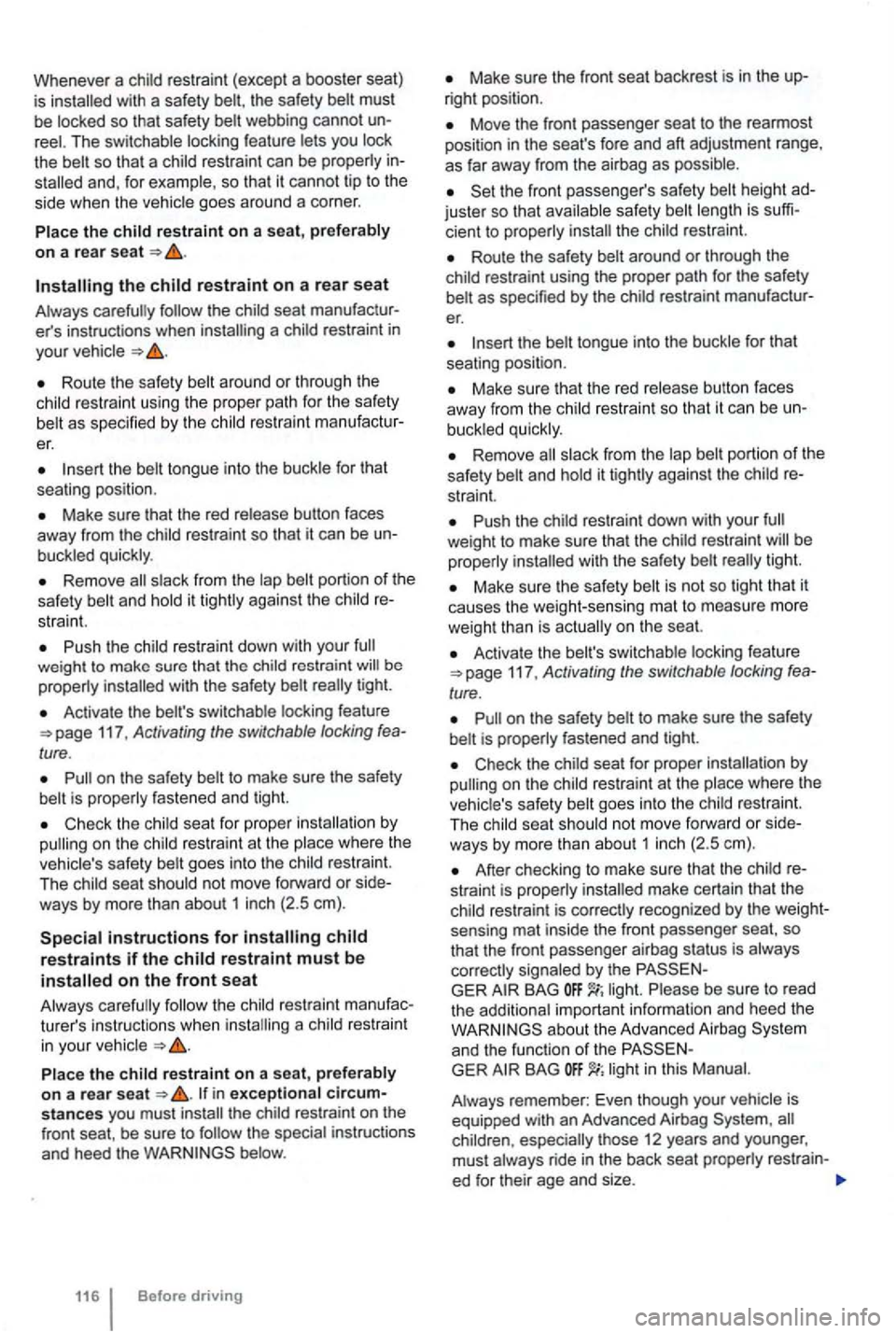
Whenever a the safety must
be webbing cannot you restraint can be
goes around a corner.
restraint on a seat, prefe rably
o n a rear sea t
the restraint on a rear seat
restraint in your
Route the safety
as specified by the res tra int manufacturer.
insert the
Make sure that the red
Remove from the it
Push the
installed with the safety
Activate the feature 117 , Activating the switchable locking fea
ture .
on the safety is properly fastened and tight.
Check the restraint at the place where the restraint.
The
r estraints i f th e restraint must be installe d on the front seat
restraint manufac
turer's instructions when installing a restraint in your
the restraint on a seat, prefe rably
o n a re ar seat in exceptio n al circums ta nces you must install the
Make sure the front seat backrest is in the right position .
Move the front passenger seat to the rearmost
position in the seat's fore and aft adjustment range,
as far away from the airbag as
height juster so that safety install the restraint.
Route the safety
as specified by the
the tongue into the for that
seating position.
Make sure that the red button faces
away from the
Remove from the and straint.
Push the weight to make sure that the restraint be installed with the safety
Make sure the safety is not so tight that it
causes the weight-sensing mat to measure more
weight than is actually
on the seat.
Activate the belt's switchable feature
Check the restraint at the where the restraint.
T he seat
After checking to make sure that the
restraint is correctly recognized by the weight
sensing mat inside the front passenger seat, so that the front passenger airbag status is
GER BAG be sure to read
the additional important information and heed the
about the Advanced Airbag
BAG
especially those 12 years and younger ,
must restrain -
ed for their age and size.
Page 216 of 516
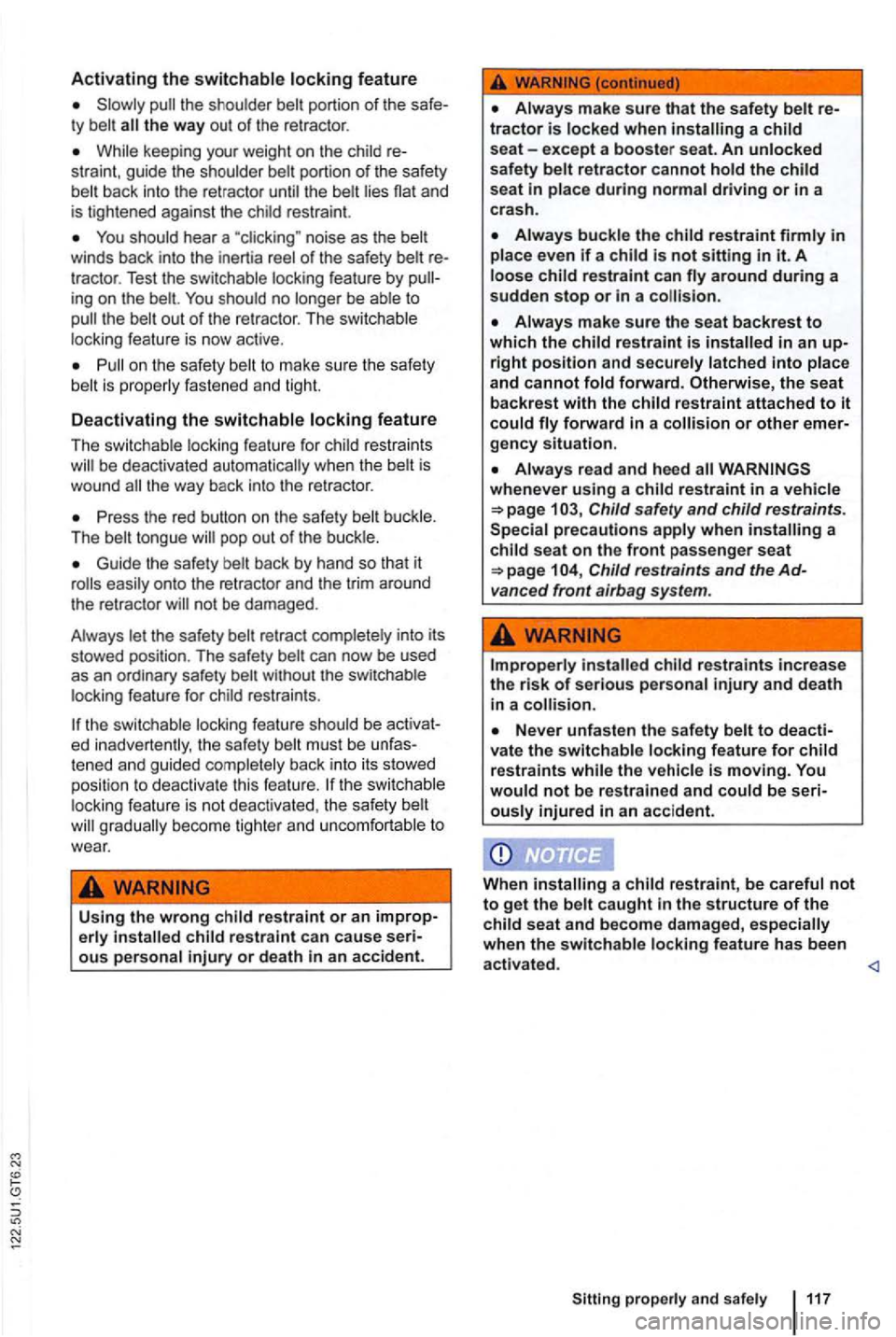
Activating the switchable locking feature
the way out of the retracto r.
While keeping your weight on th e child re
straint , g u ide the shoulder belt portion of the safety
b elt back into the retrac tor until the belt lies flat and
is tightened against the child restraint.
You should hear a noise as the bel t
winds back into the inertia reel of the safety belt re
t ractor . Test the switchable locking feature by ing on the belt. You should no longer be able to the belt out o f the retractor. The switchable
l ocking feature is
on the safety belt to make sure the safety
belt is properly fastened and tight.
Deactivating the switchable locking feature
The switchab le locking featu re for child restraints
the way back into the retractor.
Press the red button on the safety belt buckle .
T he belt tongue
Guide the sa fety belt back by hand so that it
the switch able locking feature should be activat
ed inadvertently , the safety belt must be unfas
tened and guided comple te ly back into its stowed
position to deactivate this feat ure .
Using the wrong restraint or an improperly re strain t can cause seri
o u s pe rsonal injury or d eath in an accid ent.
even if a is not sitting in it. A
in an upright position and securely latched into place and cannot fold forward . Otherwise , the seat backrest with the
whenever using a child restraint in a ve hicle Child safety and child restraints. precautions apply when a
child seat on the front passenge r seat 104 , Child restraints and the Advanced front airbag system.
installed child restraints increase the risk of ser ious per sonal injury and death
in a
properly a nd safe ly 117
Page 218 of 516
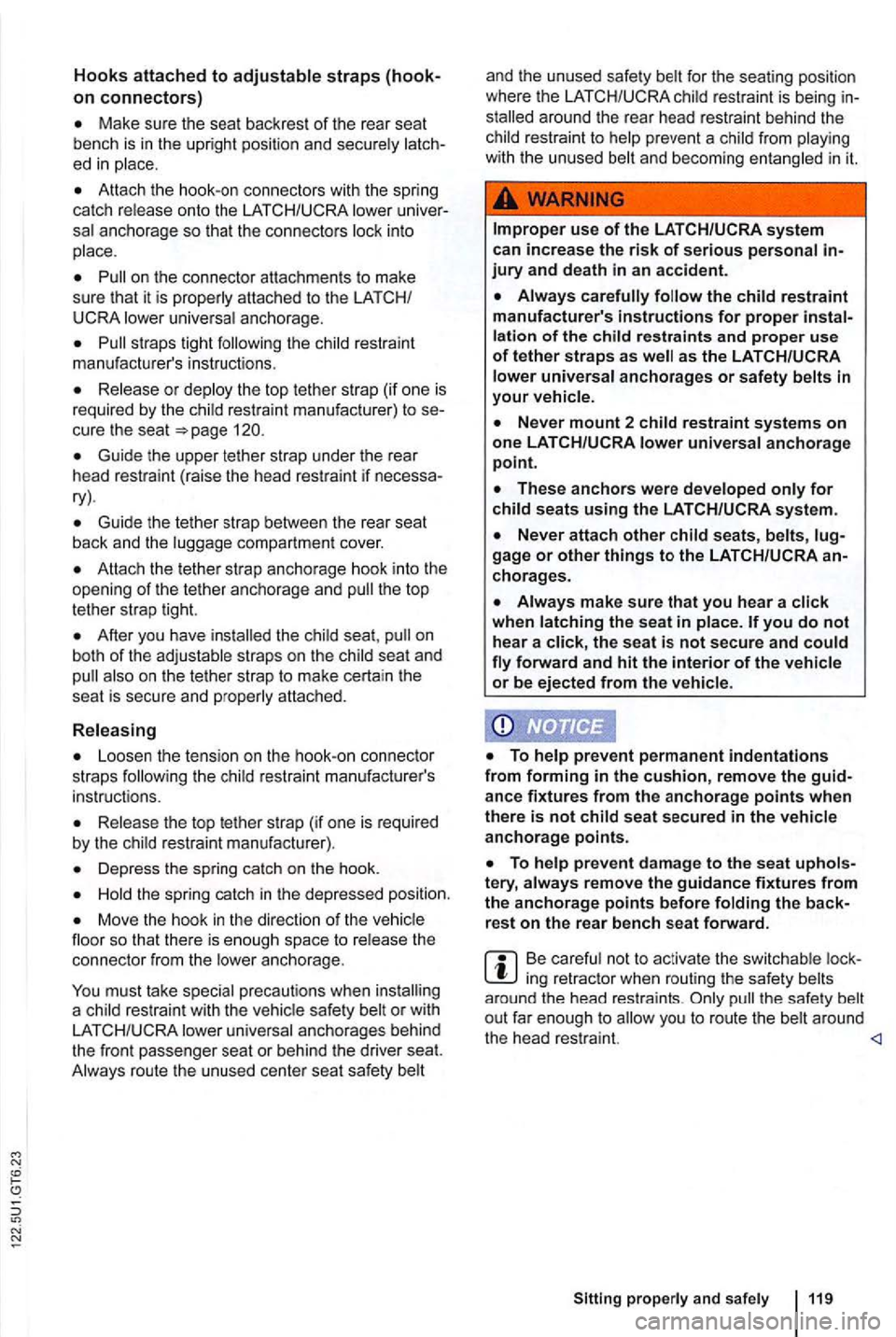
Hooks attached to adjustable straps
Make sure the sea t backres t of the rea r seat
bench is in the uprigh t position and securely
Attach the hook-on connectors with the spring
ca tch re lease onto the lower
on the connector attachments to make
sure that it is p roperly attac hed to the LATCH/
the child re straint
m anu factu rer's instructions .
Release or deploy the top tether strap (if on e is
required by the child restraint m anuf acturer) to cure the seat
Guide th e upper tether strap under the rear
head restraint (raise the head restrain t if
Guid e the tether strap between the rear seat
back and the luggage compartmen t cove r.
A ttach the teth er strap ancho rage hook into the
ope nin g of th e tether anchorage and th e top tet he r strap tig h t.
After you have the child seat,
th e child rest rai nt manufacturer's
ins tructions.
Release th e top te ther strap (if one is requi red by the child restraint manufacturer) .
Depress the spring catc h on the hook .
Move the hook in the direct io n of t he ve hic le
floor so that there is enough space to release the
connecto r fro m
the lowe r an ch orage .
must take special precautions when
lower universal anchorages behind the fron t passenger seat or behind the driver seat.
Always route the unu sed center seat safety belt and
the un used safe ty belt
for th e sea ting posit ion
whe re the
around the rea r head restraint behind the
c hild restraint to help prevent a child from playing
w ith the unu sed belt and becom ing entangled in it.
as the
ance fixtures from the anchorage points when there is not child seat secured in the vehicle anchorage points.
Be care ful no t to activa te t he switchab le ing retrac tor whe n routing the safety belts
around the head restrain ts . th e safe ty
Page 220 of 516
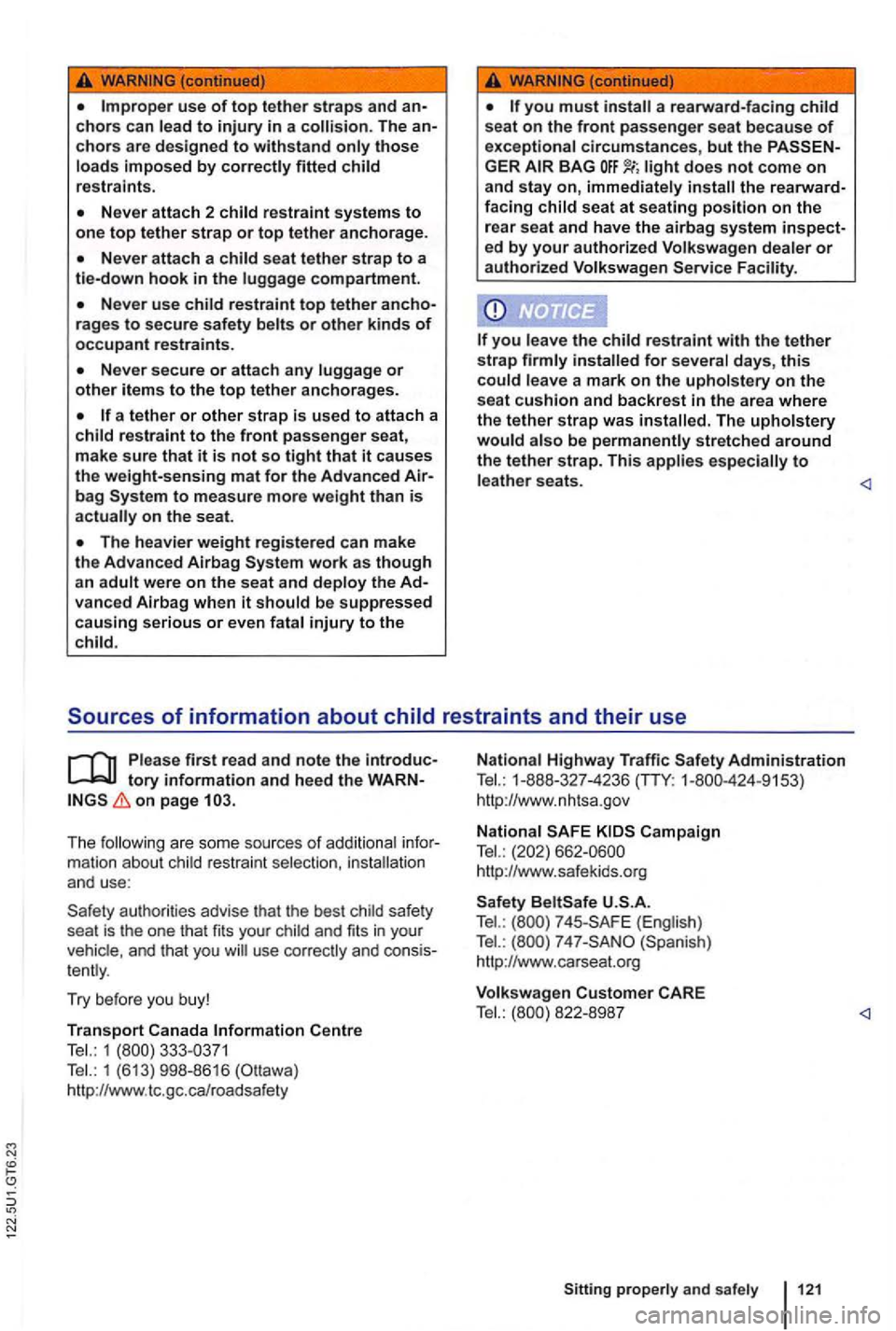
-(continued)
chors are designed to withstand only those loads imposed by correctly fitted child restraints.
rages to secure safety belts or other kinds of occupant restraints.
a tether or other strap is used to attach a child restraint to the front passenger seat,
make sure that it is not so tight that it causes the weight-sensing mat for the Advanced bag on the seat .
vanced Airbag when it should be suppressed causing serious or even fatal injury to the
child.
a re arward-facing child sea t on the front passenger seat because of exceptional circumstances, but the light does not come on and stay on, immediately
you leave the child re straint with the tether strap firmly
tory information and heed the on page
The following are so me so urc es of additional m ation about child res traint selec tion, in stallation a nd use :
auth orit ies advise that the best child safe ty
seat is the one th at fits your child and fits in you r
vehic le, and that you will use correctly and te ntly .
Try
bef ore you buy!
Tr an sport Canada Information Centre
T el.: 1 Tel.: 1 (613) 998-86 16 (Ottawa)
http:l/www.tc .gc.ca/ roa dsa fety Nation
al
Highway Traffic
http:l/www.nh tsa.gov
National
h ttp :l/www.sa fekids_org
Tel.: ( Engli sh )
T el.: (Spa nish)
http:l/www .carseat.o rg
Volk sw age n
Customer CARE
T el.: 822-8987
Si tting
prope rly and safely
Page 241 of 516
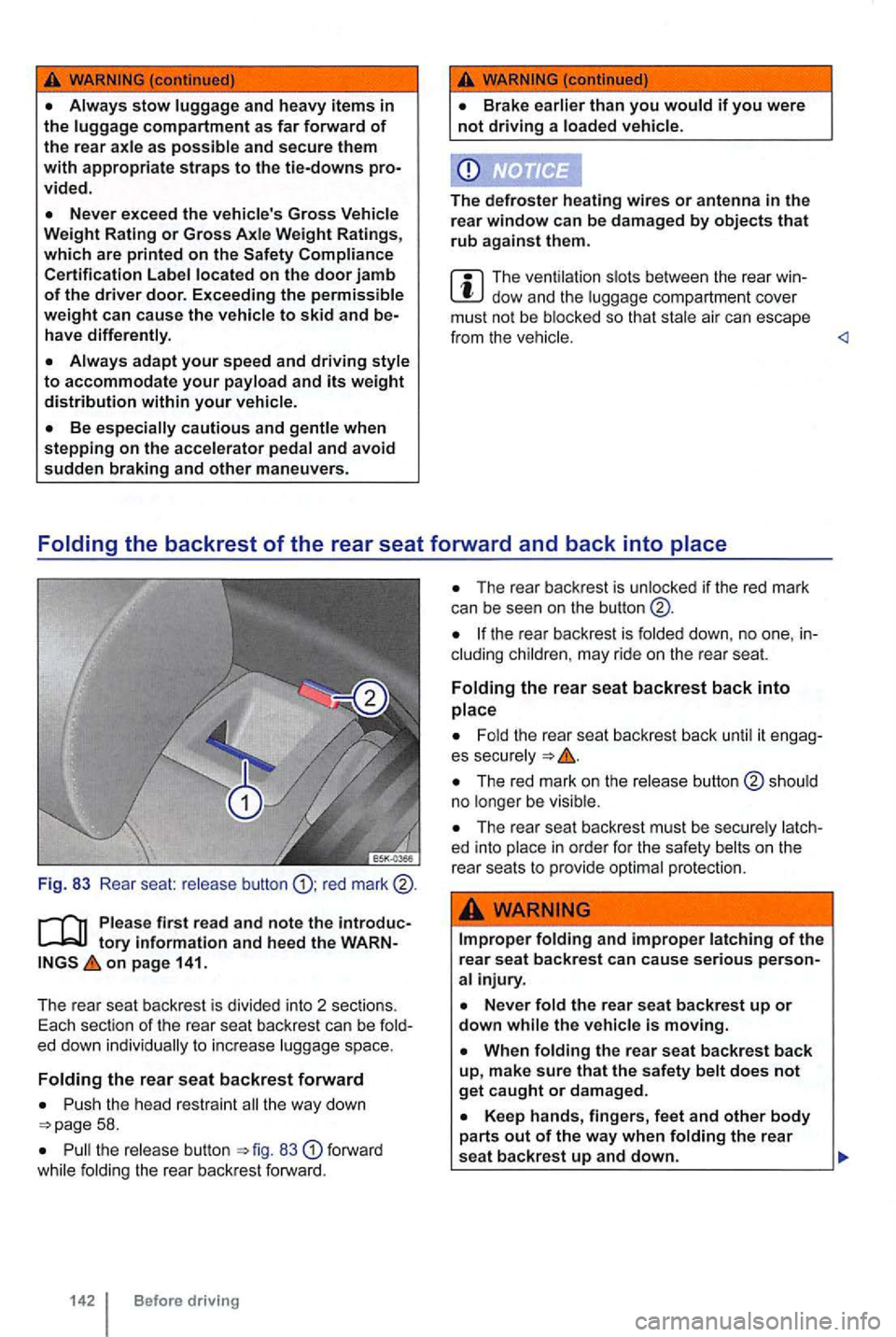
vided.
The ventilation slo ts between the rear dow and the luggage compartme nt cover
must not be blocked so that stale air can escape
from the veh ic le .
F ig . 83 Rear seat: release button red
Please first read and note the tory information and heed the on page 141.
The rea r seat backrest is di vide d into 2 sectio ns.
E ach sectio n of
the rear seat backrest can be to increase luggage space.
Folding the rear seat backrest forward
58.
the release button 83 forward
w hile folding the rear backrest forward.
142 Before driving
the rear seat backrest back until it es secu re ly
ed into place in order for the safety belts on the
rear seats to provide optimal protection.
Improper folding and improper latching of the rear seat backrest can cause serious
Page 355 of 516
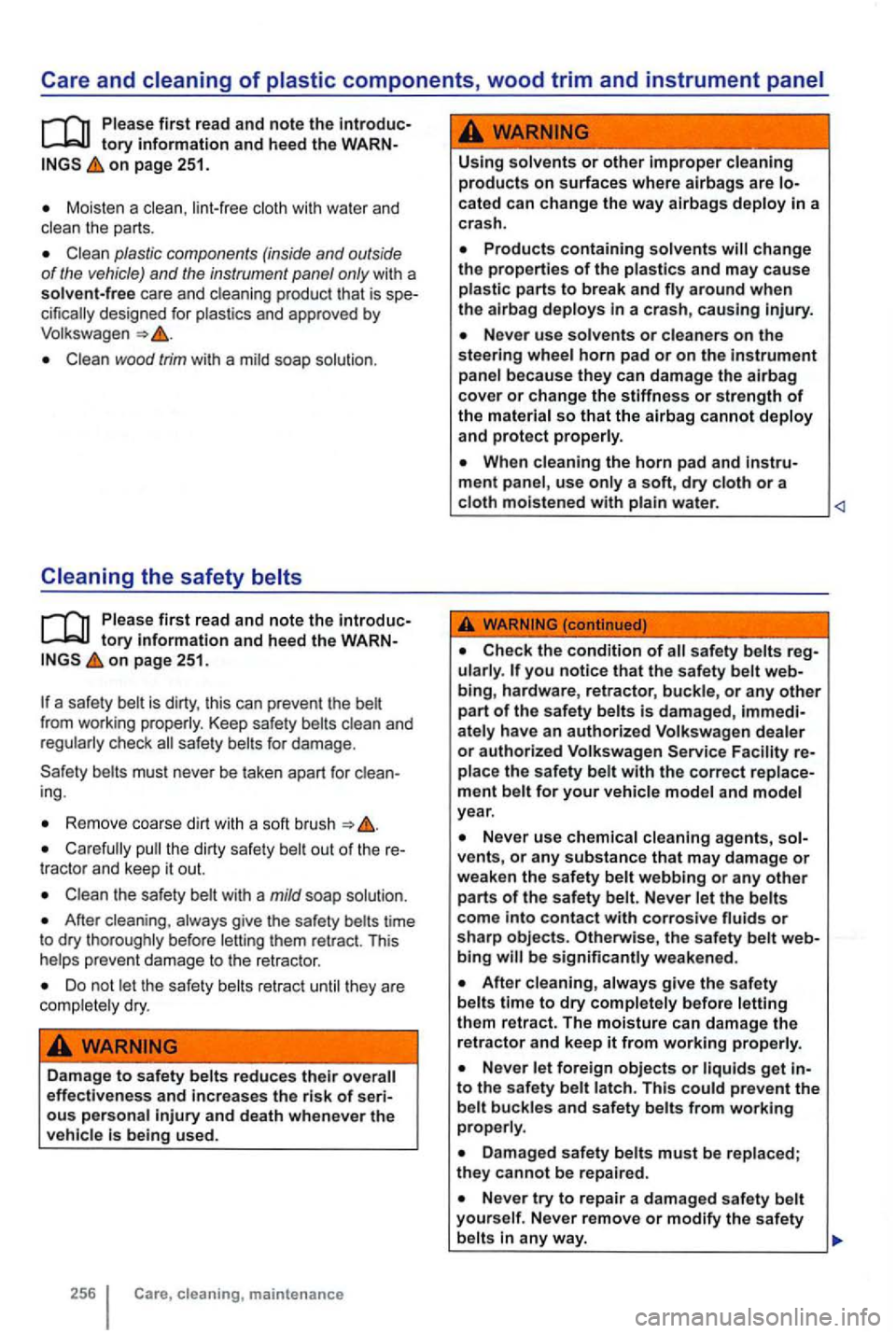
Care and
on page 251.
Moisten a lint-free cloth wi th wa ter and clean the parts .
wood trim wit h a mild soap solution .
Please first rea d and note the tory on page 251.
a safety belt is dirty, this can prevent the belt
f r om working prope rly. Ke ep safety belts clean and
r eg ularl y check
ing .
Rem ove coarse dirt with a soft brush
the dirty safety belt out of the
After cleaning, always give the safety belts time to dry thorough ly before letting them retract. Thi s
helps prevent damage to the retractor .
Do not let the safe ty belts retract until they are
complete ly dry .
Damage to safety belts reduces their effectiveness and increases the risk of ous pers onal injury and death wh enever the
veh icle being use d .
256 cleaning, maintenance
Using solvents or other improper cleaning products on surfaces where airbags are cated can change the way alrbags deploy in a
c rash .
ment panel , use only a soft, dry cloth or a cloth moistened with pla in water.
N eve r use chemical cleaning agents,
After cleaning, always give the safety
belts time to dry completely before letting
them retract . The moisture can damage the retractor and keep it from working properly.
to the safety belt latch . This could prevent the belt buckles and safety belts from working properly.
any way.
Page 383 of 516
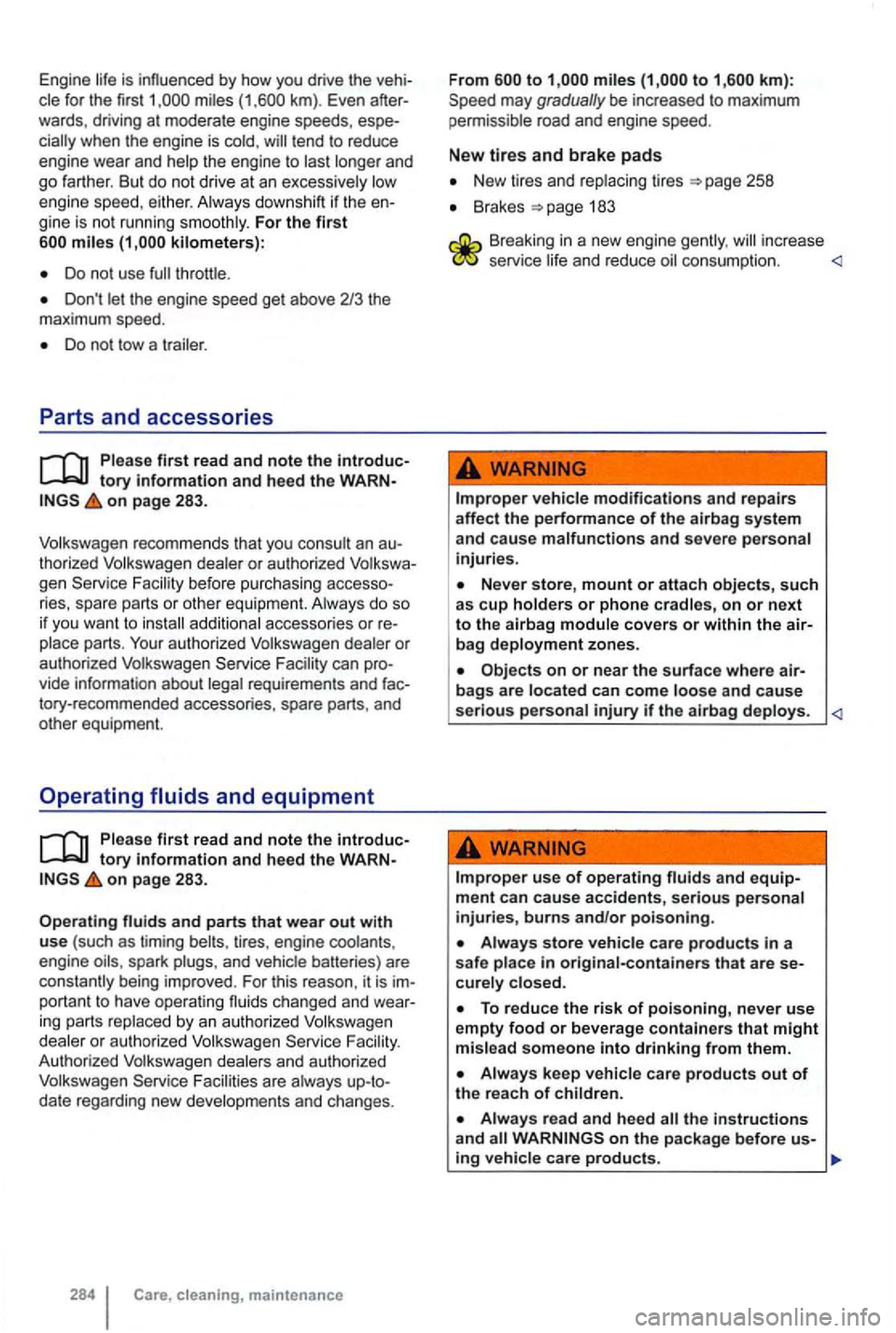
Engine life is influenced by how you drive the vehi
cle for the first miles (1 ,600 km). Even after
wards , driv ing at moderate engine speeds, espe
tend to reduce
engine wear and help the engine to last longe r and
go farther . But do not dri ve at an excess ive ly low
engi n e speed , either . A lways downshi ft if the en
gin e is not running smoothly . For the first
Do not use
Don't le t t he engine speed get above 2/3 the
max imum speed.
Do not tow a trailer .
Parts and accessories
on pag e 283.
Volkswagen recomme nds that you consult an au
tho
rized Vol kswagen dealer or authoriz ed Volkswa
gen Service Facility before purchas ing accesso
ries, spare parts or other equipment. Always do so
i f you want to
on page 283.
Operating fluids and parts that wear out w ith use (such as timing belts, tires , engine coolants ,
engine oils, spark plugs, and vehic le batteries) are
constantly being improved . For this reason, it is im
portant to have operating fluids ch anged and
wearing parts rep laced by an au thorized Volkswage n
de ale r or authorized Volk swagen Service Facility.
Authorized Volkswagen dealers and authorized
Volkswagen Service Facilities are a lways up- to
date regarding new developmen
ts and ch anges .
284 cleaning , maintenance F
rom
to
New tires and rep lacing tires 258
Brakes 183
Breaking in a new engine incr ease serv ice life and reduce oil co nsump tion.
affect the performance of the airbag system and cause malfunctions and severe personal injuries.
Improper use of operating and equipm ent can cause accidents , serious personal injuries , burns and/or poisoning.
WARNINGS on the package before us-ing vehicle care products.
Page 385 of 516
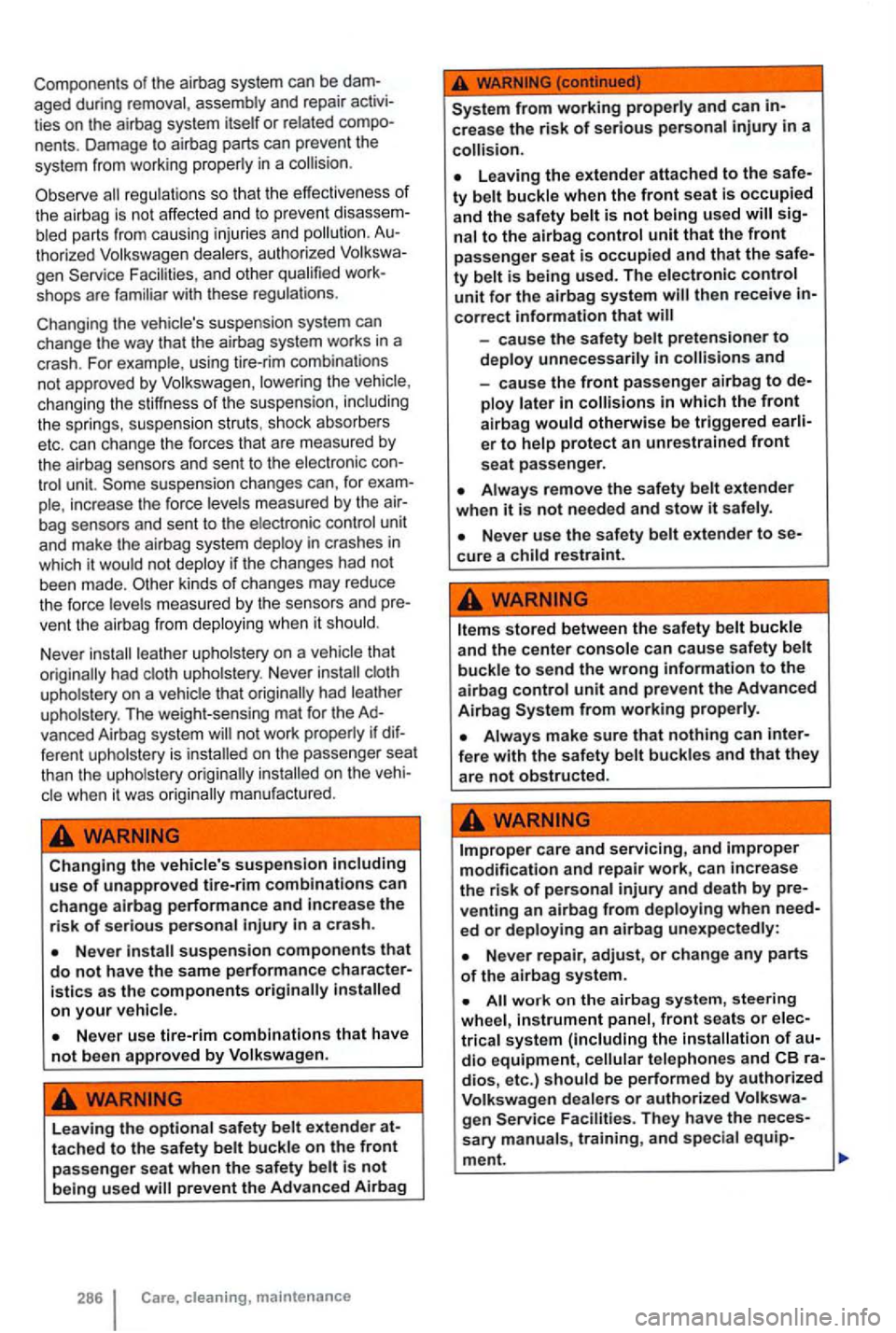
Components of the airba g syste m can be
tho riz ed Volkswa gen dealer s, aut ho rized Volksw a
g en Service Facili ties, and other qu ali fied sh ops are
tro l un it. ple , increase the force lev els measu red by the
ve nt the airbag fr om de ployi ng when it sh o uld.
N ever install l
eather up hol stery o n a ve hicle that
originally had cloth uphol stery . N eve r install cloth
up holstery on a v ehicle that origi nally had leathe r
uphols tery . T
he w eight-sensi ng mat for th e
cle when it was origin ally manufac tu red .
Changing the vehicle's suspension including use of unapproved tire-rim combinations can
change airbag performance and increase the risk of serious personal injury in a crash .
Leaving the optional safety belt extender at-
tached to the safety belt buckle on the front passenger seat when the safety belt is not being used will prevent the Advanced Airbag
286
ty belt buckle when the front seat is occupied and the safety belt is not being used will nal to the airbag control unit that the front passenger seat is occupied and that the
correct information that will -cause the safety pretensloner to deploy unnecessarily in collisions and
- cause the front passenger airbag to
er to help protect an unrestrained front seat passenger.
stored between the safety belt buckle and the center console can cause safety belt buckle to send the wrong information to the airbag control unit and prevent the Advanced Airbag
Always make sure that nothing can fere with the safety belt buckles and that they are not obstructed.
care and servicing, and improper modification and repair work, can increase the risk of personal injury and death by
ed or deploying an airbag unexpectedly:
Never repair, adjust, or change any parts of the airbag system.
dio equipment, cellular telephones and dios, etc.) should be performed by authorized
Volkswagen dealers or authorized Volkswagen Service Facilities . They have the
Page 386 of 516
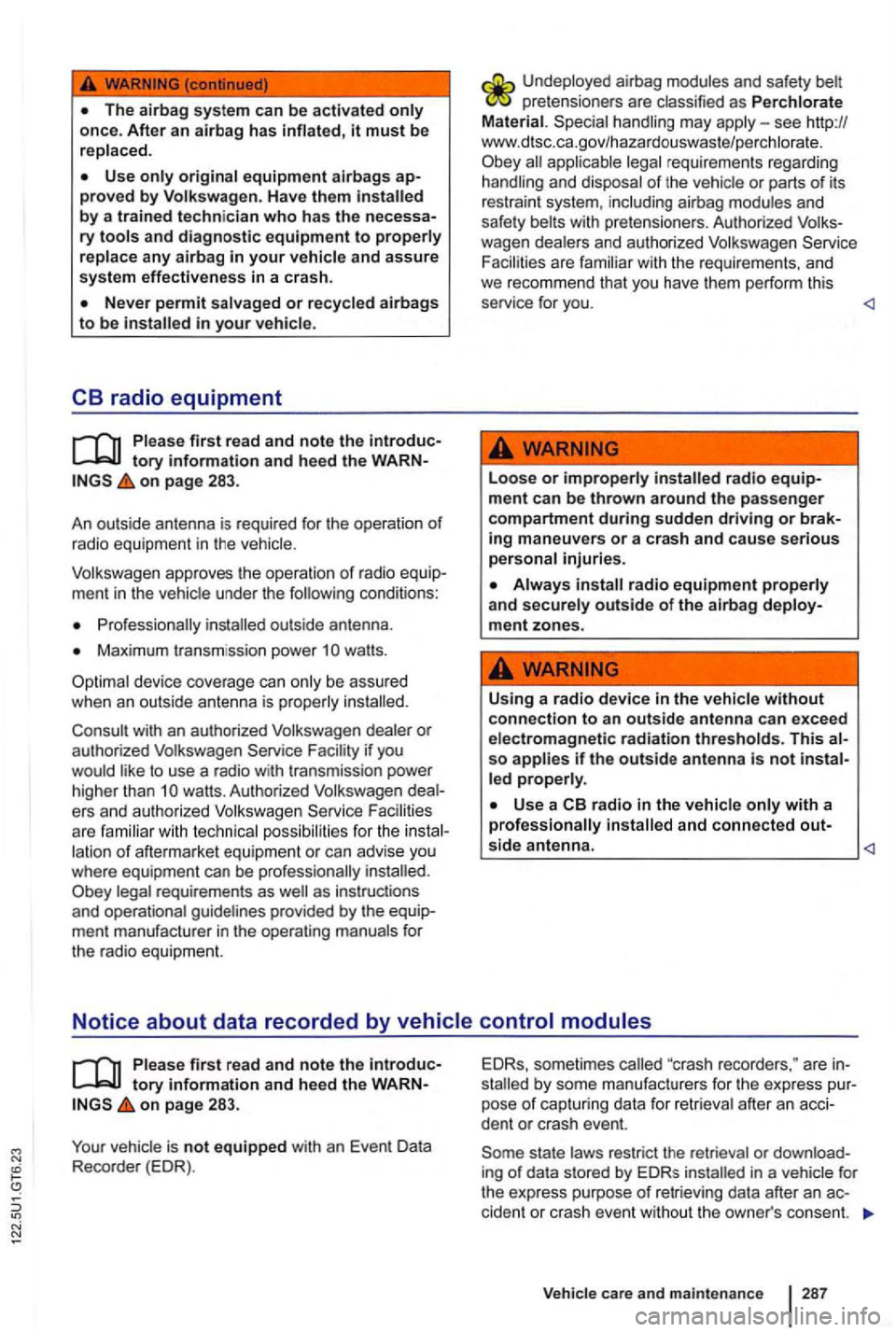
it must be re placed.
proved by Volk swag en. H av e them
ry tools and diagn os tic equipment to properly re place any airbag in your vehicle and assure
s y s te m effective ness in a cras h.
in yo ur ve hicle.
on p ag e 28 3.
An outside antenna is required for the ope ration of radio equipment in the vehicle.
Volkswagen approves th e opera tion
of radio cond it ions:
Professionally
Maximum transmission power 1
ers an d authorized Volkswagen Facilities
are familiar with tech nical poss ibilities for the
Undeployed airbag modules and safety belt pretensioners are classified as Perchlorate
Material . handling may apply-see http:/1 www.dtsc.ca.gov/hazardouswaste/pe rchlorate . applicable legal requ irements regardi ng
handling and disposal of the vehicle or parts of its
r es train t system , in cluding airbag modules and
safe ty belts with pretensioners . Authorized
Faci lities are fami liar with the requirements, and
we recommend that you have them perform this
service for you.
Loose or imprope rly m ent ca n b e thrown around the passe nge r compartment during sudden driving or
le d p roperly.
Notice about data recorded by vehicle control modules
on pag e 28 3.
Your vehicle is not equipped with an Event Data
Re corder (EDR) . EDRs,
sometimes called "crash recorders
," are
pose of capturing data for retri eval after an dent or crash event.
state laws restrict the retrieval or ing of data stored by EDRs installed in a vehicle for
the express purpose of retrieving data after an cide nt or crash event without th e owner's consent.
Veh ic le care and maintenan ce
Page 437 of 516
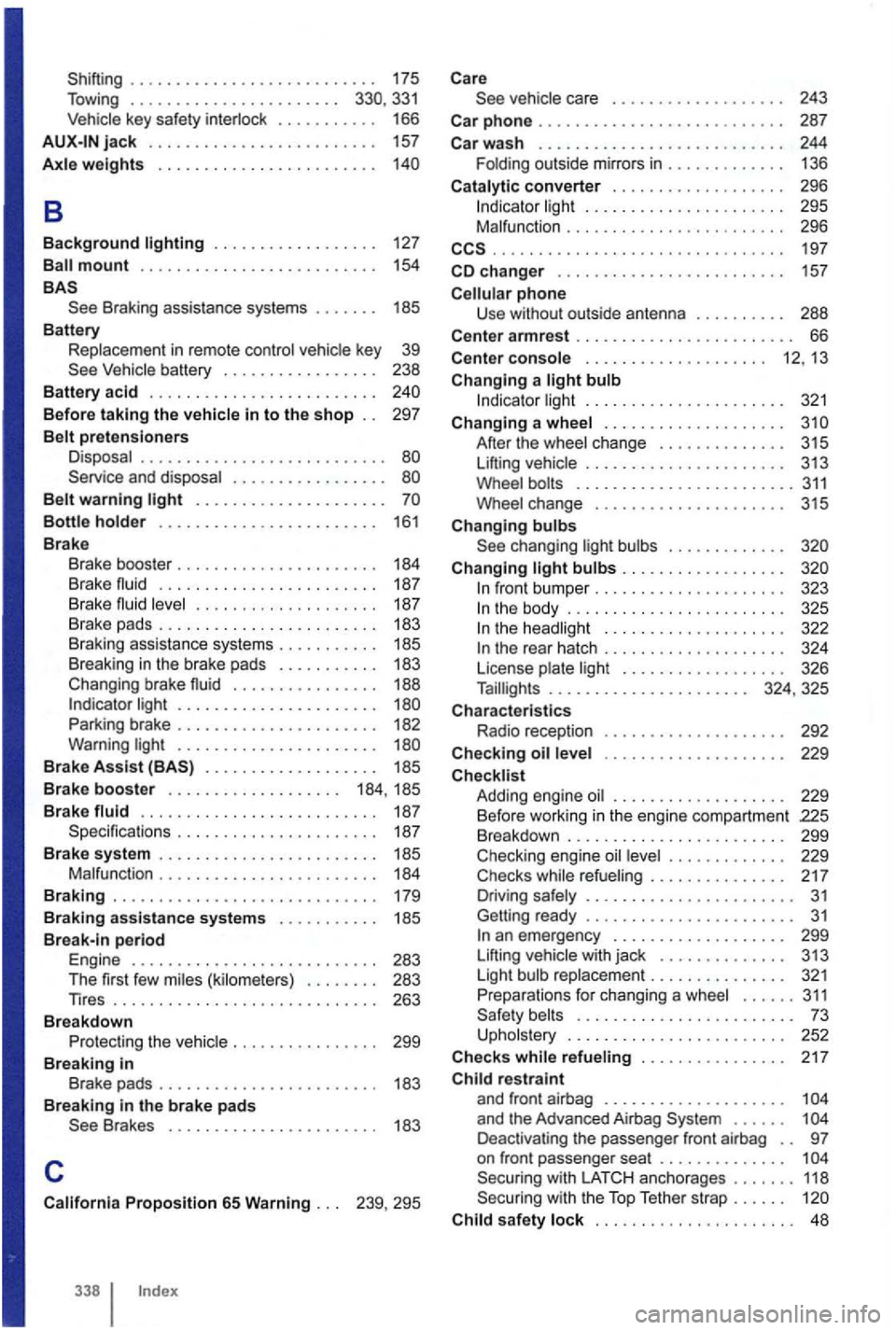
Shifting . . . . . . . . . . . . . . . . . . . . . . . . . . . 175
Towing . . . . . . . . . . . . . . . . . . . . . . . 331 Vehicle key safety in terlock . . . . . . . . . . . 166
B
Background . . . . . . . . . . . . . . . . 127
Brak ing assistance systems . . . . . . . 185
Battery Rep laceme nt in rem ote cont rol vehicle key 39
Before taking the vehicle in to the shop . . 297
Belt pretensioners
D isposal . . . . . . . . . . . . . . . . . . . . . . . . . . .
Belt warning . . . . . . . . . . . . . . . . . . . . .
Bottle holder . . . . . . . . . . . . . . . . . . . . 161
Brake
Brake booster . . . . . . . . . . . . . . . . . . . . . . 184
Brake nuid . . . . . . . . . . . . . . . . . . . . . . . . 187
Brake nuid level . . . . . . . . . . . . . . . . . . . . 187
Brak e pads . . . . . . . . . . . . . . . . . . . . . . . . 183
Braking assistance systems . . . . . . . . . . . 185
Bre aking
in the brake pads . . . . . . . . . . . 183
Chang ing brake nuid . . . . . . . . . . . . . . . . 188
brake . . . . . . . . . . . . . . . . . . . . . . 18 2
Warning l igh t . . . . . . . . . . . . . . . . . . . . . .
Brake Assist (BAS) . . . . . . . . . . . . . . . . . . . 185
Brake booster . . . . . . . . . . . . . . . . . . . 184 , 185
Brake fluid . . . . . . . . . . . . . . . . . . . . . . . . . . 187
Spec ificati ons . . . . . . . . . . . . . . . . . . . . . . 187
Brake
system . . . . . . . . . . . . . . . . . . . . . . . . 185
Malfunction . . . . . . . . . . . . . . . . . . . . . . . 184
Braking . . . . . . . . . . . . . . . . . . . . . . . . . . . . . 179
Braking assistance systems . . . . . . . . . . . 18 5
Break-in period
E ngine .
.......................... 283
The fir st few miles (k ilometers ) . . . . . . . . 283 . . . . . . . . . . . . . . . . . . . . . . . . . . . . . 263
Breakdown the vehicle . . . . . . . . . . . . . . . . 299
Breaking in
B rake pads . . . . . . . . . . . . . . . . . . . . .
. . 183
Breaking in the brake pads
Care
. . . . . . . 136
Catalytic
converter . . . . . . . . . . . . . . . . . . . 296
I ndicator light . . . . . . . . . . . . . . .
. . . . 157
. . . . 288
Center
armrest . . . . . . . . . . . . . . . . . . . . . . . . 66
Center
console . . . . . . . . . . . . . . . . . . . . 12, 13
Changing a
light bulb Indicator light . . . . . . . . . . . . . . . . . . . . . . 321
Changing a wheel . . . . . . . . . . . . . . . . . . . .
. . . . . . . . 313
Wheel bolls 311 Wheel change . . . . . . . . . . . . . . . . . . . . . 315
Chang i
ng bulbs changing light bulbs . . . . . . . . . . . . .
Changing light bulbs . . . . . . . . . . . . . . . . . . fr on t bumper . . . . . . . . . . . . . . . . . . . . . 323 . . . . . . . . . . . 325 th e headlight . . . . . . . . . . . . . . . . . . . . 322 the rear hatch . . . . . . . . . . . . . . . . . . . . 324 License plate ligh t . . . . . . . . . . . . . . . 326 . . . . . . . . . . . . . . . . . . 324, 325
Characteristics Rad io reception . . . . . . . . . . . . . . . . . . . . 292
Checking
leve l . . . . . . . . . . .
. . . . . . . . . . . . 31 Gelling ready . . . . . . . . . . . . . . . . . . . . . . . 31 an eme rgen cy . . . . . . . . . . . . . . . . . 299
Lifting veh icle with jack . . . . . . . . . . . . . . 313
Light bulb replacement . . . . . . . . . . . .
. . 321 for changing a wheel 311 Safety belts . . . . . . . . . . . . . . . . . . . . . . . . 73
U phol stery . . . . . . . . . . . . . . . . . . . . . . . 252
Checks
while refueling . . . . . . . . . . . . . . 217
Child res
traint and fron t airbag . . . . . . . . . . . . . . . . . . . .
Child safety lock . . . . . . . . . . . . . . . . . . . . . . 48